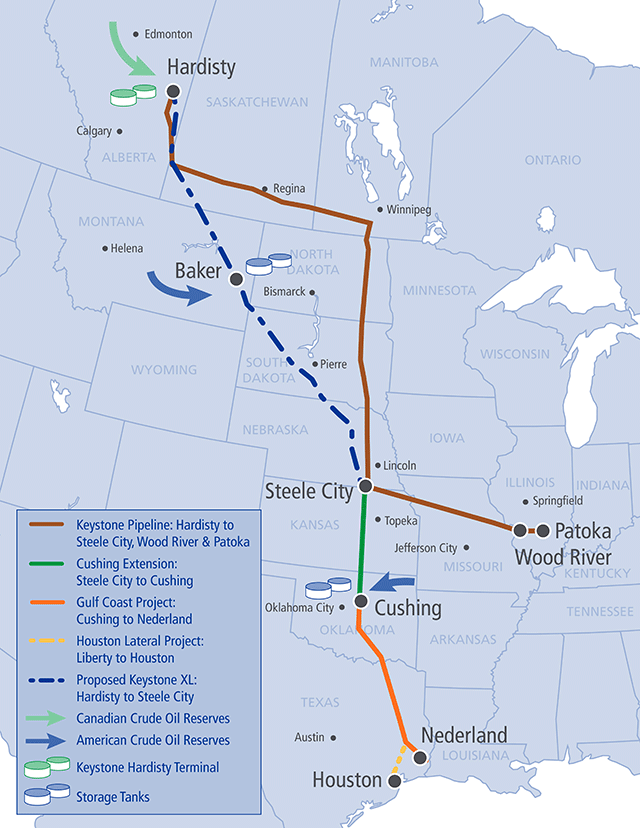20,000 U.S. Jobs, $7B Project Stuck in Limbo
As of July 9, the Keystone Project has been studied for 2,119 days, according to the House Energy and Commerce Committee. No other pipeline has taken so long to gain approval.
On July 8, 44 diverse organizations, from businesses to labor unions, sent a letter supporting the speedy approval of TransCanada’s Keystone Pipeline to Secretary of State John Kerry.
The Keystone XL pipeline was originally proposed in Sept. 2008 as an extension of the existing Keystone Pipeline. The goal was to transport crude oil from Alberta, Canada, to U.S. refineries along the Gulf coast. According to the Department of Energy, Keystone XL would be able to move up to 830,000 barrels of oil per day, representing about half the amount that the U.S. imports from the Middle East.
On its Keystone update page, the U.S. Department of State web site says: “The 30-day public comment period closed on March 7, 2014. The Department is reviewing and appropriately considering the more than 2.5 million public comments it received during the comment period. Public comments are posted at www.regulations.gov, Docket ID: DOS-2014-0003.
“The Department continues to review the Presidential Permit application for the proposed Keystone XL pipeline in a rigorous, transparent, and objective manner.
“The Presidential Permit review process focuses on whether the proposed Project serves the national interest, which involves consideration of many factors including: energy security; environmental, cultural, and economic impacts; foreign policy; and compliance with relevant federal regulations and issues. During this time, the Department will consult with, at least, the eight agencies identified in Executive Order 13337: the Departments of Defense, Justice, Interior, Commerce, Transportation, Energy, Homeland Security, and the Environmental Protection Agency.”
Environmentalists, ranchers and farmers in Nebraska had challenged the route of the pipeline, claiming it puts their livelihoods and communities at risk. But the U.S. Department of State Bureau of Oceans and International Environmental and Scientific Affairs’ report on the Keystone project showed that it will have minimal impact on greenhouse gas emissions or the nearby environment. The group argued that Nebraska’s pending court decision is unrelated to Congress’ approval, since “the issue of our national interest will not be affected or changed by the outcome of the Nebraska decision.”
On February 8, 2011, the second phase of TransCanada’s Keystone Pipeline system began delivering crude to Cushing, Oklahoma.
The pipeline has strong citizen and bipartisan support, according to polls from the Washington Post and ABC News.
The delay in obtaining the Keystone XL Pipeline National Interest Determination and the Presidential Cross-Border Permit has Canada looking at alternative markets for its oil. In June the Canadian Government approved the construction of Enbridge’s Northern Gateway pipeline project that would transport its oil to the country’s West coast, from which it could be shipped to Asia. “Enbridge’s pipeline would transport 525,000 barrels of oil a day from Alberta’s oil sands to the Pacific to deliver oil to Asia, mainly energy-hungry China. About 220 large oil tankers a year would visit the Pacific coast town of Kitimat… ,” an AP story reported.
[sam_ad id=”32″ codes=”true”]
Important disclosures: The information provided herein is believed to be reliable; however, EnerCom, Inc. makes no representation or warranty as to its completeness or accuracy. EnerCom’s conclusions are based upon information gathered from sources deemed to be reliable. This note is not intended as an offer or solicitation for the purchase or sale of any security or financial instrument of any company mentioned in this note. This note was prepared for general circulation and does not provide investment recommendations specific to individual investors. All readers of the note must make their own investment decisions based upon their specific investment objectives and financial situation utilizing their own financial advisors as they deem necessary. Investors should consider a company’s entire financial and operational structure in making any investment decisions. Past performance of any company discussed in this note should not be taken as an indication or guarantee of future results. EnerCom is a multi-disciplined management consulting services firm that regularly intends to seek business, or currently may be undertaking business, with companies covered on Oil & Gas 360®, and thereby seeks to receive compensation from these companies for its services. In addition, EnerCom, or its principals or employees, may have an economic interest in any of these companies. As a result, readers of EnerCom’s Oil & Gas 360® should be aware that the firm may have a conflict of interest that could affect the objectivity of this note. The company or companies covered in this note did not review the note prior to publication.


